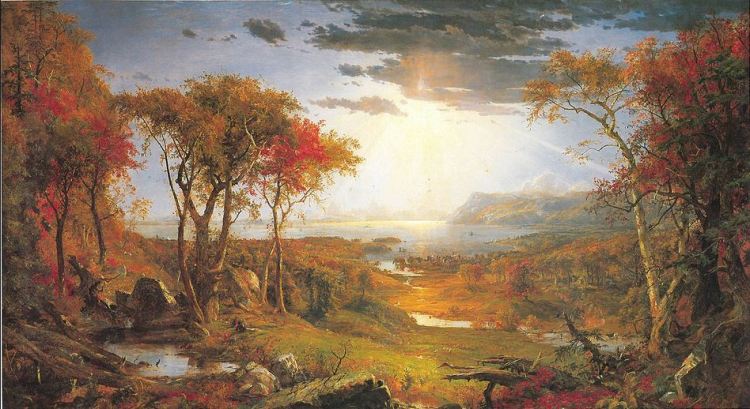Albert Bierstadt was born in Solingen, Prussia, on January 7, 1830, but he spent his early years in New Bedford, Massachusetts, where his parents settled two years after his birth. Henry Bierstadt, the artist’s father, found work as a cooper in the capital of America’s whaling industry.
Primarily self-taught, Albert Bierstadt began his professional career in 1850 when he advertised his services as a drawing instructor. Three years later he departed for Europe, hoping Johann Peter Hasenclever (1810-1853), a distant relative and prominent member of the Dusseldorf school of artists, would help him obtain formal instruction. Hasenclever died suddenly, however, shortly before Bierstadt’s arrival. When Emanuel Leutze (1816-1868) and Worthington Whittredge (1820-1910) came to his aid Bierstadt found, unexpectedly, American rather than German mentors.
After nearly three years in Dusseldorf, Bierstadt joined Whittredge on an extended sketching tour through Germany, Switzerland, and Italy. Following a winter in Rome and a sketching tour to Naples and Capri, Bierstadt returned to New Bedford in the fall of 1857. Described as a “timid, awkward, unpolished specimen of a Yankee” when he arrived in Dusseldorf in 1853, Bierstadt returned to New Bedford four years later a socially poised and technically mature painter.
In the spring of 1858 he made his New York debut when he contributed a large painting of Lake Lucerne and the Swiss Alps to the annual exhibition at the National Academy of Design. Critics were dazzled by Bierstadt’s technical expertise; within weeks he was elected an honorary member of the academy.
Bierstadt’s European apprenticeship served him well the following spring when he journeyed west for the first time, joining Frederick W. Lander’s survey party bound for the Rocky Mountains. Though not the first artist to see or even paint the Rockies, Bierstadt was the first who brought with him superior technical skills and considerable experience painting European alpine peaks. For Americans eager to finally see the mountains a generation of travelers had described as “America’s alps,” Bierstadt’s credentials were near perfect.
By late September 1859 Bierstadt had returned to New Bedford laden with field sketches, stereo photographs, and Indian artifacts. Within three months he had moved to New York, established himself in the Tenth Street Studio Building, and begun to exhibit the western paintings that would soon make his reputation. He completed the most important of these, The Rocky Mountains, Lander’s Peak (Metropolitan Museum, New York), in the spring of 1863 just weeks before he set off on his second journey west.
Accompanied by Fitz Hugh Ludlow, a celebrated writer who later published a book about their overland adventure, Bierstadt traveled to the Pacific Coast. He spent several weeks in Yosemite Valley completing the plein air studies he would later use to compose several of his most important paintings. Following a trip north through Oregon to the Columbia River, Bierstadt and Ludlow returned east. Utilizing studies gathered during all stages of his journey, Bierstadt completed, by the end of the decade, a remarkable series of large scale paintings that not only secured his position as the premier painter of the western American landscape but also offered a war-torn nation a golden image of their own Promised Land.
In 1867 Bierstadt and his bride set sail for London. It was a triumphant return for the emigrant’s son who had arrived in Europe fourteen years earlier an eager but impoverished student. Six months after his arrival Bierstadt was invited to exhibit two of his most important paintings (both of which had been purchased by English railroad entrepreneurs), privately before Queen Victoria. During the more than two years he remained abroad, Bierstadt traveled, sketched, and cultivated the friendships that would sustain a European market for his work for many years.
In July 1871, Bierstadt and his wife boarded the recently completed transcontinental railroad bound for San Francisco. Apart from the artist’s brief return to New York that autumn, they remained in California until October 1873. As he had since his days in Dusseldorf, Bierstadt spent much of his time traveling in remote regions completing the field studies he would later use to compose studio paintings.
In the fall of 1876 Rosalie Bierstadt, who had been diagnosed as consumptive and advised to spend the winter months in a warm climate, made her first trip to Nassau. Until her death in 1893, Rosalie spent increasingly longer periods in Nassau. Though Bierstadt continued to maintain his New York studio and travel widely in the West and Canada, he found new subject matter in the tropics during visits with his wife. In 1880 he exhibited one of the most successful of these pictures, The Shore of the Turquoise Sea (Private Collection), at the National Academy of Design. Though praised by some, the painting drew fire from critics who had found fault with his “theatrics” as early as the 1860s.
Critical disfavor and a falling market plagued Bierstadt during his later years. The most telling blow came in 1889 when the American committee charged with selecting works for the Exposition Universelle in Paris rejected Bierstadt’s entry, The Last of the Buffalo (Corcoran Gallery of Art). Described as too large but more likely judged old-fashioned, the painting marked the end of Bierstadt’s series of monumental western landscapes.
Bierstadt died suddenly in New York on February 18, 1902, largely forgotten. Ironically, renewed interest in his work was sparked by a series of exhibitions in the 1960s highlighting not the great western paintings but rather the small oil sketches he had used as “color notes” for the panoramic landscapes that had brought him such success in the 1860s. [This is an edited version of the artist’s biography published in the NGA Systematic Catalogue]








![]()













